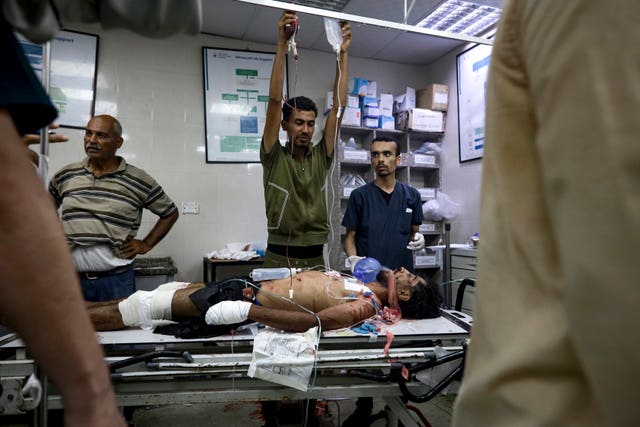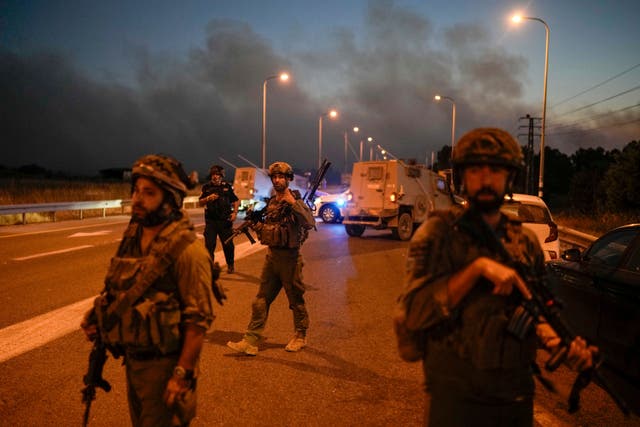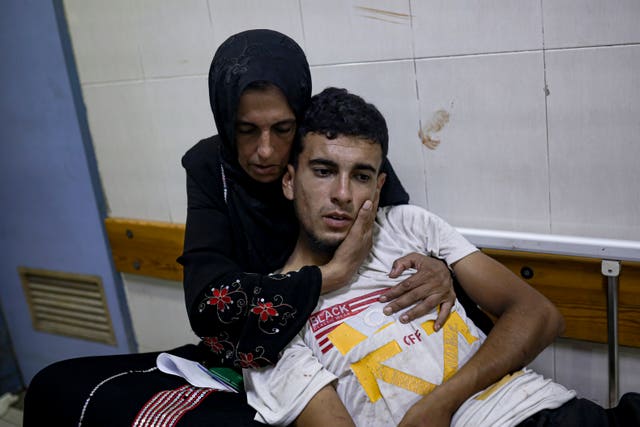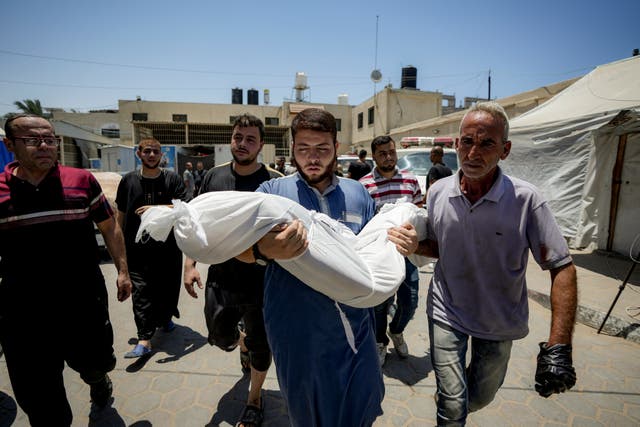The Israeli military said on Wednesday that it has ordered the evacuation of Gaza City, which was an early target of the war that is now seeing renewed fighting.
The military dropped leaflets on the city, calling on people to head south and saying “Gaza City will remain a dangerous combat zone.”
The evacuation order could signal that Israel is expanding an incursion into the city, where it has been operating in several outlying neighbourhoods in recent days.
It is the latest sign that Hamas is regrouping in areas that Israel previously said it had cleared of militants.

Earlier on Wednesday, Israeli air strikes killed 20 Palestinians in central Gaza, including six children and three women, some of them inside a purported “safe zone” declared by the Israeli military, hospital authorities said.
The second straight night of deadly strikes in the central town of Deir al-Balah and nearby refugee camps came as US, Egyptian and Qatari mediators as well as Israeli officials met in the Qatari capital, Doha, for talks aimed at agreeing a long-elusive deal for a ceasefire and hostage release.
Israel and Hamas have appeared to narrow the gaps in recent days, but obstacles remain.
Strikes early on Wednesday hit three houses in the Nuseirat refugee camp, killing 12 people including five children, said authorities at al-Aqsa Martyrs Hospital, where the casualties were taken. An Associated Press reporter counted the bodies.
The camp, like others around Gaza, was originally erected to house Palestinians driven from their homes during the 1948 war surrounding Israel’s creation. It has grown into an urban neighbourhood in the decades since.
A fourth strike early on Wednesday killed four men, three women and a child when it hit a home in Deir al-Balah, an area that is located within the “humanitarian safe zone” where Israel has told Palestinians to seek refuge as it carries out offensives in multiple parts of the Gaza Strip.

The overnight bombardment came hours after Israeli warplanes struck the entrance of a school sheltering displaced families outside the southern city of Khan Younis.
The toll from the strike rose to 31 people killed, including eight children, and more than 50 wounded, officials at the nearby Nasser Hospital said on Wednesday.
Footage aired by Al-Jazeera television showed children playing football in the school’s yard when a sudden boom shook the area, prompting shouts of “a strike, a strike!”
The Israeli army said the air strike near the school and reports of civilian casualties are under review, and claimed it was targeting a Hamas militant who took part in the October 7 attack on Israel, though it provided no immediate evidence.
The military blames civilian deaths on Hamas because the militants fight in dense, urban areas. But the army rarely comments on what it is targeting in individual strikes, which often kill women and children.
In nine months of bombardment and offensives in Gaza, Israel has killed more than 38,200 people and wounded more than 88,000, according to the territory’s Health Ministry, which does not distinguish between combatants and civilians in its count.
Nearly the entire population have been driven from their homes. Many have been displaced multiple times, and hundreds of thousands are packed into sweltering tent camps.

Israel’s onslaught was triggered by Hamas’s cross-border raid on October 7, during which militants killed 1,200 people in southern Israel, most of them civilians, according to Israeli authorities.
The militants took roughly 250 people hostage. Around 120 are still in captivity, with about a third said to be dead.
This week, Israeli troops have also been waging a new ground assault in Gaza City in the north of the territory – its latest effort to battle Hamas militants regrouping in areas the army previously said had been largely cleared.
Large parts of Gaza City and urban areas around it have been flattened or left a shattered landscape by previous Israeli assaults, and much of the population fled earlier in the war. But the latest incursions and bombardment prompted a new flight of people.
After Israel called on Monday for an evacuation from eastern and central parts of Gaza City, staff at two hospitals – Al-Ahli and the Patients Friends Association Hospital – rushed to move patients and shut down, the United Nations said.
The Israeli military said on Tuesday that it told hospitals and other medical facilities in Gaza City they did not need to evacuate. But hospitals in Gaza have often shut down and moved patients at any sign of possible Israeli military action, fearing raids.
In the past nine months, Israeli troops have attacked at least eight hospitals, causing the deaths of patients and medical workers along with massive destruction to facilities and equipment. Israel has claimed Hamas uses hospitals for military purposes, though it has provided only limited evidence.
Only 13 of Gaza’s 36 hospitals are functioning, and those only partially, according to the United Nations’ humanitarian office.

International mediators are making a new concerted effort to push through a proposed ceasefire deal.
An Egyptian official said the head of Egypt’s General Intelligence Service, Abbas Kamel, went to Doha to join discussions over the deal. He said US and Israeli officials are also attending.
A day earlier, CIA director William Burns, who has led the American mediation, met Egyptian President Abdel Fattah el-Sissi in Cairo.
Obstacles remain in the talks, even after Hamas agreed to relent on its key demand that Israel commit to ending the war as part of any agreement. Hamas still wants mediators to guarantee that negotiations conclude with a permanent ceasefire.
Israel has rejected any deal that would force it to end the war with Hamas intact.
On Monday, Hamas accused Israeli Prime Minister Benjamin Netanyahu of “putting more obstacles in the way of negotiations”, including the operations in Gaza City.
On Wednesday a United States official said the head of the agency overseeing American foreign humanitarian and development aid will visit Israel on Thursday to address security concerns around aid workers and aid distribution in Gaza.
US Agency for International Development (USAID) administrator Samantha Power will meet Israeli officials to discuss improving communication and co-ordination to protect humanitarian workers in the war. She was last in the region in March, when she visited Israel, Jordan and the Israeli-occupied West Bank.
According to the UN, more than 200 aid workers have been killed in Gaza since the war began.
Ahead of Ms Power’s visit, the Israeli military asserted that the UN must step up its ability to receive and distribute aid in Gaza.
“Even if we will bring 1,000 trucks today, there’s nowhere to put it on the Palestinian side, that’s the main problem,” said Colonel Elad Goren, the head of the civilian department at the Israeli defence body in charge of Palestinian civilian affairs, during a press conference.
USAID has said thousands of tons of food, medicine and other aid are piled up uncollected on a beach near the US-built pier because of the lawlessness on the ground.




Comments: Our rules
We want our comments to be a lively and valuable part of our community - a place where readers can debate and engage with the most important local issues. The ability to comment on our stories is a privilege, not a right, however, and that privilege may be withdrawn if it is abused or misused.
Please report any comments that break our rules.
Read the rules hereLast Updated:
Report this comment Cancel